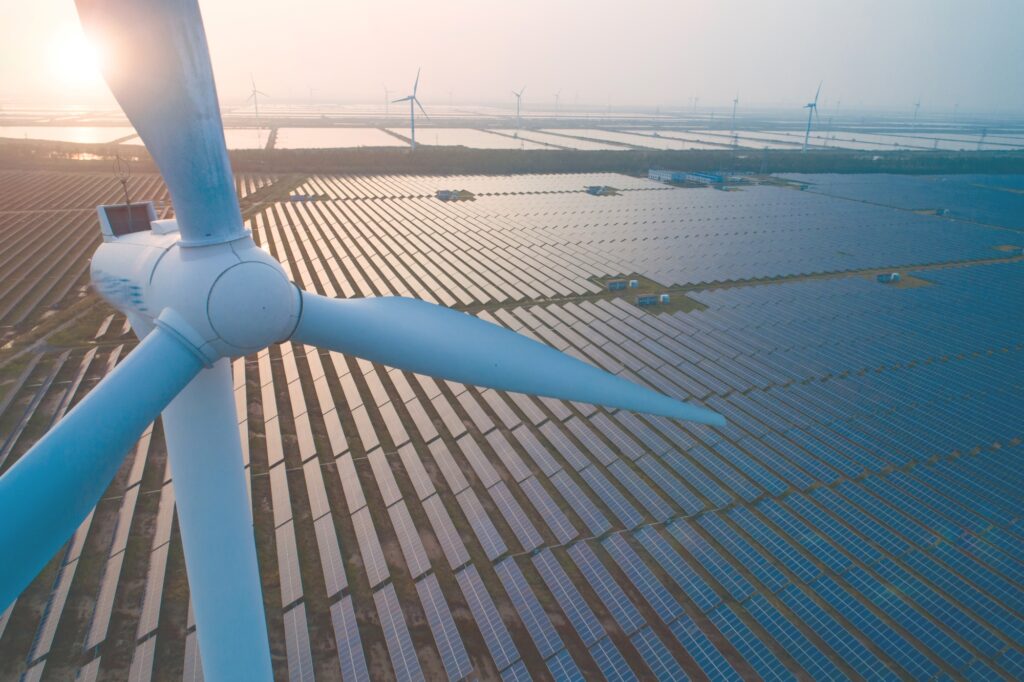
PE funds producing returns and carbon credits may attract corporates with business, suppliers and cash in China.
Mounting pressure on corporates to achieve net-zero carbon emissions or carbon neutral targets is prompting more of them to consider investing in private equity (PE) strategies focused on renewable energy assets. The trend is in its early stages, and companies need to thoroughly vet impact fund managers and understand regional investment characteristics before taking the plunge. But it’s clear that treasury and finance teams working with sustainability officers to meaningfully address climate change need to weigh the relative merits of impact investments that may contribute to reducing a corporate’s carbon footprint.
A spotlight on China. Interest in such renewable funds may be particularly strong among companies doing business in China, the biggest source of global greenhouse gas emissions as well as where many multinationals have key suppliers resulting in scope 3 emissions (carbon in a business’s value chain that it doesn’t control but which it indirectly impacts). The fund structure can offer corporates an investment opportunity for excess or trapped cash, producing a financial return in addition to carbon credits.
- China is a critical growth market for many companies committed to climate neutrality but may present a challenge to those that want to purchase renewable energy. The good news is that the Green Electricity Certificates issued by the Chinese government to owners of renewable energy assets can be transferred from the asset holding company of a PE fund to a corporate investor in proportion to the amount invested in the fund. The transfer is only allowed once, to be used solely as an offset and not to trade, according to DWS.
Renewable energy and climate fund pioneers. Tech powerhouses Microsoft, Apple, Amazon and Google have helped plant the seeds for a new crop of companies moving toward investing in PE funds for renewables, making direct investments in clean energy projects, or creating venture capital funds that support the development of technology aimed at reducing carbon emissions and extracting carbon from the atmosphere.
- In 2020, as part of its pledge to become carbon negative by 2030, Microsoft launched a $1 billion climate innovation fund to accelerate the global development of carbon reduction, capture and removal technologies. The fund makes direct investments and also invests in other impact funds, including a $1 billion fund managed by Energy Impact Partners that invests in venture and growth companies pursuing climate solutions. Other corporate investors in the fund include Duke Energy, Cox Enterprises and Entergy Corp.
- Another example is the TPG Rise Climate Fund, which announced in July, 2021 it had raised $5.4 billion from investors, including more than a dozen multinationals, such as 3M, Boeing and Nike. The PE fund has a hard cap of $7 billion and invests in “a portfolio of companies that can enable carbon aversion in a quantifiable way,” according to TPG. However, the fund’s investors do not receive carbon credits as part of their return, a TPG spokesman said.
- To address carbon footprints directly through investments, corporates need to invest in renewable energy assets, said Andrew Pidden, Head of Sustainable Investments at DWS. In 2018, one large corporate launched a fund managed by DWS of several hundred million dollars so that the company and its suppliers in China could invest in renewable energy (solar and wind farms) and accrue carbon credits alongside a targeted financial return.

Casting a wider net. In that vein, DWS is working on another strategy in Asia to facilitate the move by corporates to carbon neutrality and “greening” their supply chains. The asset manager’s goal is to attract companies that need to address carbon footprints and supplier emissions in China and prefer to do so through an investment that yields renewable energy credits (RECs) and a financial return, rather than buying credits as an offset that end up as a recurring expense and lack the additionality of building new renewable energy assets.
- “We believe the additionality of investing in newly built renewable energy assets is an important outcome from these strategies,” said Priscilla Lu, Head of Sustainable Investments for Asia Pacific at DWS. “The money that goes to the purchasing of carbon credits as offsets is not making any transformational changes; whereas an investment in a PE fund focused on new renewable energy projects is delivering not only the financial returns and RECs to the investor, but the renewable energy developer now has access to capital to do more projects.”
- Mr. Pidden added, “The great advantage of doing it in a fund structure for corporates is that they are outsourcing the many complex steps in the process to a fund team with experience. We employ renewable energy engineers, turbine certification professionals as well as renewable finance experts. This enables a lot of diligence costs to be minimized as well as ensuring the management of the assets, the accounting of the energy generated and certificates produced is professionally managed. When that is spread across a number of investors in a fund, it becomes a compelling value proposition.”
- Today, suppliers in China have a greater incentive to invest alongside large corporates in funds focused on renewables given the Chinese government’s pledge to achieve carbon neutrality by 2060, Mr. Pidden said. “It’s even more relevant for them now to pursue a renewable energy investment approach because not only are they trying to manage scope 3 emissions for customers around the globe, but they are also well positioned for the growing need to show their own governments that they’re addressing this issue.”
Options to consider, questions to ask. Finance teams contemplating investments to help their companies meet carbon emission goals need to consider their options and direction from the C-suite. “Part of that internal company process has to be determining whether they take a multifaceted approach” that includes long term investments like private equity, said Louise Moretto, Senior Investment Specialist for DWS Sustainable Investments.
- “What are the requirements from a treasury perspective for them to invest in these projects? A lot of that will depend on internal investment guidelines and policies that govern longer-term commitments,” she added. “When you invest in private equity, you’re committing to seven to eight years, generally.” DWS says this long-term commitment is consistent with ensuring corporates accrue the needed RECs on a regular and long-term basis.
- “One of the basic questions upfront is how a company wants to address its carbon footprint,” Ms. Moretto said. Some companies prefer building their own renewable energy projects on site for their operations or to purchase green energy through power purchase agreements (PPAs). Corporates that want more control or need to offset relatively more emissions may opt to invest in renewable projects on their own.
- If investing in new renewable energy assets through a fund is deemed a feasible approach, the process for companies should start with quantifying their emissions including their supply chain partners, Ms. Moretto said. “The company would determine their carbon footprint and work with DWS to then estimate the investment size needed for that market to generate the carbon credits required.”

Choosing PE managers, goals. Mr. Pidden said corporates must verify that the investment will produce the desired RECs. “The diligence the corporate needs to go through on a fund provider should really be robust around their experience generating the actual impact that the corporate needs and confirming that the reporting mechanism that the asset manager will deliver can prove that the outcomes being generated are real,” he said. Having a deep understanding of local country markets, especially in China, as well as having a team on the ground is also key, he added.
- Corporates should also test the flexibility and knowledge of asset managers, Mr. Pidden argues. “Most active fund managers probably aren’t aware of all the issues that corporates face that could be resolved by an investment approach. Companies should feel empowered to challenge asset managers to come up with solutions for the problems they have right now. There’s choice out there. It’s worth having more than one conversation.”
Define your target. Companies considering private equity investment strategies should decide whether their aim is carbon neutrality, net-zero or carbon negative. At one extreme stands Microsoft, which plans by 2050 to “remove from the environment all the carbon the company has emitted either directly or by electrical consumption since it was founded in 1975.”
- At DWS, “Our strategy, which is global, is to address corporations’ need to attain carbon neutrality, not necessarily net-zero, and our focus is specifically on energy,” Dr. Lu said. “There are many industries creating significant carbon footprints and they are not able to directly reduce or remove their CO2 emissions.”
- She cited a transit company dependent on electricity in a city state with no renewable energy. “There is no way for this company to address their carbon footprint except to do this through investments in renewable energy.”
- She concluded, “Ultimately, the objective of climate change initiatives is to reduce and remove CO2 emissions, and any amount of investment funding directed to enabling additional transformational change to help accelerate the transition has the potential to have impact and make a difference—that is where we are focused, and where we believe we can add value as asset managers.”
Sponsored by

DWS and NeuGroup are not affiliated. This sponsored content has been written for informational and educational purposes only and should not be considered as investment advice or as a recommendation of any particular security, strategy or investment product. The article reflects current market and regulatory conditions, which are subject to change without notice.
Private equity strategies are complex and may be suitable only for very sophisticated investors who, based on their own investment expertise or that of their financial advisor, understand its strategy, characteristics and risks. Investments in private equity strategies are speculative and involve a high degree of risk. Investors should be aware of the attendant risks including, but not limited to the potential for higher fees and lack of strategy transparency. Private equity strategies may employ a single strategy, which may result in a lack of diversification, and consequently higher risk.
The comments, opinions and estimates contained herein are based on or derived from publicly available information from sources believed to be reliable. We do not guarantee their accuracy. This material is for informational purposes only and sets forth our views as of this date. The underlying assumptions and these views are subject to change without notice. No assurance can be made that the stated investment objectives will be achieved.


